Bulletin #2615, Tips for Growing Houseplants in Maine: Creating New Plants from Old Plants
Tips for Growing Houseplants in Maine: Caring for Houseplants in Maine (PDF)
Tips for Growing Houseplants in Maine: This newly revised and expanded fact sheet series addresses the basics of keeping houseplants. It will help you diagnose common problems with your houseplants, such as insects and diseases; overwatering or underwatering; improper lighting, temperature, or humidity; and insufficient pot size (root-bound). The series addresses how to start new plants from old plants, and also the unique challenges of growing houseplants in Maine, including the use of artificial light.
Adapted by Donna Coffin, Extension Professor, University of Maine Cooperative Extension
Reviewed by Rebecca Long, Extension Professional, and Matt Wallhead, Extension Ornamental Horticulture Specialist, University of Maine Cooperative Extension
For information about UMaine Extension programs and resources, visit extension.umaine.edu.
Find more of our publications and books at extension.umaine.edu/publications/.
A great many houseplants can be propagated by one or several types of cuttings. Cuttings, or slips, are the stems or leaves cut off the parent or stock plant. These severed parts, after a period of time, generate new stems and roots. The most common types of cuttings are stem cuttings and leaf cuttings.
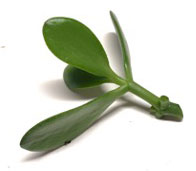
Stem Tip Cuttings
Stem tip cuttings are made from the ends of actively growing shoots. The cuttings can range from 3 to 5 inches and must be removed at a point just below a leaf (Figure 1). For best results, the cutting should have three or four leaves. Remove any leaves on that portion of the stem being inserted into the rooting medium.
Common House Plants to be Propagated by Stem Tip Cutting
- Begonia
- Peperomia
- Coleus
- Philodendron
- English Ivy (Hedera helix)
- Poinsettia (Euphorbia pulcherrima)
- Fuchsia
- Rubber plant (Ficus elastica)
- Geranium (Pelargonium)
- Jade plant (Crassula ovata)
- Wax plant (Hoya)
- Inch Plant (Tradescantia)
- Norfolk Island pine (Araucaria heterophyll)
Leaf Cuttings
Leaf cuttings can be made from leaves with or without petioles (leaf stem). There are four common types of leaf cuttings. These include the leaf petiole cutting, whole leaf cutting, leaf bud cutting, and leaf section cutting.
Leaf Petiole Cuttings
Leaf cuttings with the petioles (leaf stems) are called leaf petiole cuttings. In this case, the leaf is cut from the parent plant at the node (point at which the leaf stem joins the main stem) and stuck into the rooting medium.
Common House Plants to be Propagated by Leaf Petiole Cuttings
- Peperomia
- Begonia
- Wax plant (Hoya)
- African violet (Streptocarpus sect. Saintpaulia)
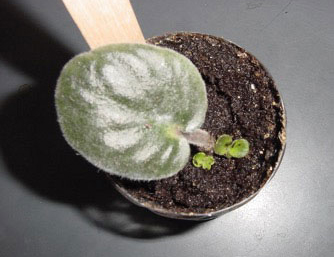
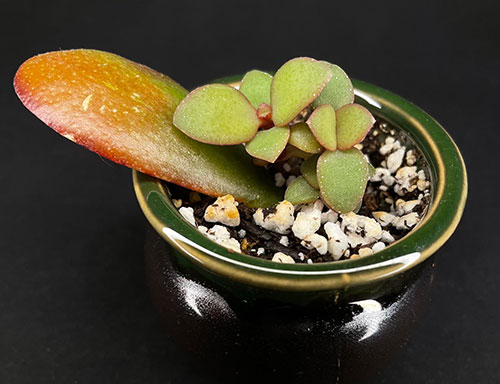
Whole Leaf Cuttings
Leaf cuttings without the leaf stems are called whole leaf cuttings. In this case, the leaf is cut from the parent plant and the base inserted into a rooting medium. Roots and leaves eventually form at the base of the leaf.
This propagation method is commonly used for many succulents. Succulent leaves can be gently snapped off, rather than cut, and placed on the rooting medium surface.
Common House Plants to be Propagated by Whole Leaf Cuttings
- Cacti
- Jade plant (Crassula ovata)
Leaf Bud Cutting
Leaf bud cuttings consist of a leaf attached to a 1- or 2-inch section of stem. A hidden or dormant bud is present at the node. In this case, the stem section is laid on its side and inserted into the growing medium.
Common House Plants to be Propagated by Leaf Bud Cutting
- English ivy (Hedera helix)
- Peperomia
- Grape ivy (Cissus alata)
- Philodendron
- Geranium (Pelargonium)
- Pothos (Epipremnum aureum)

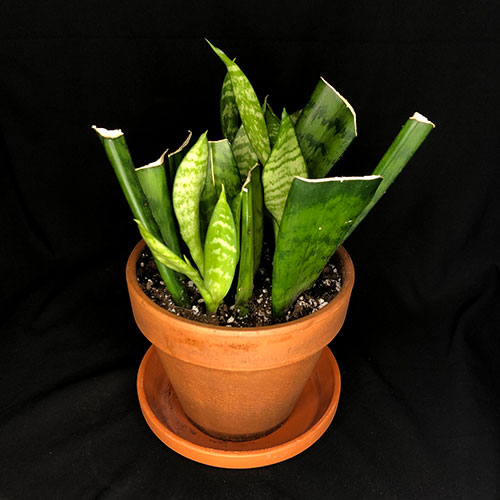
Leaf Section Cutting
Leaf cuttings consist of cut up sections of leaf. On a snake plant, for example, leaves are cut into 2–3-inch-long sections and inserted into the rooting medium, bottom end first. New roots and leaves form at the base of these cuttings.
Common House Plants to be Propagated by Leaf Section Cuttings
- Rex Begonia
- Snake plant (Dracaena trifasciata)
Procedure for Rooting Cuttings
Before making your cuttings, assemble the necessary materials. Depending on the method you use (see below), you may need some or all of these materials: a plastic bag, rooting medium, sharp knife or scissors, container, and rooting hormone.
Rooting hormone will help stimulate root development in cuttings. The cut ends of the cuttings should be moistened slightly and then dipped into rooting hormone with excess tapped-off gently. Make a small depression or hole in the medium and place cutting in the hole and pull the medium up to support the stem or leaf. Try not to rub off the rooting hormone.
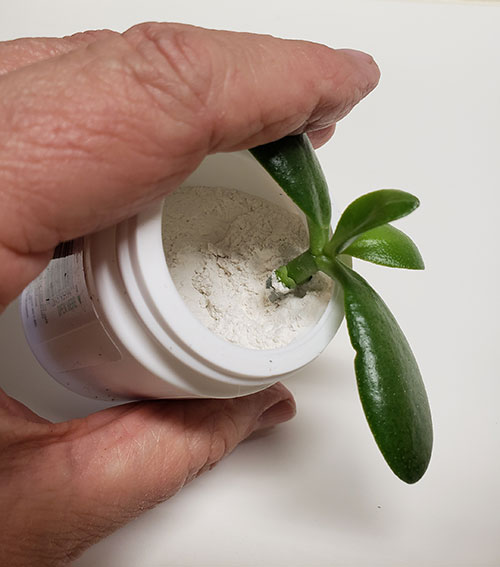
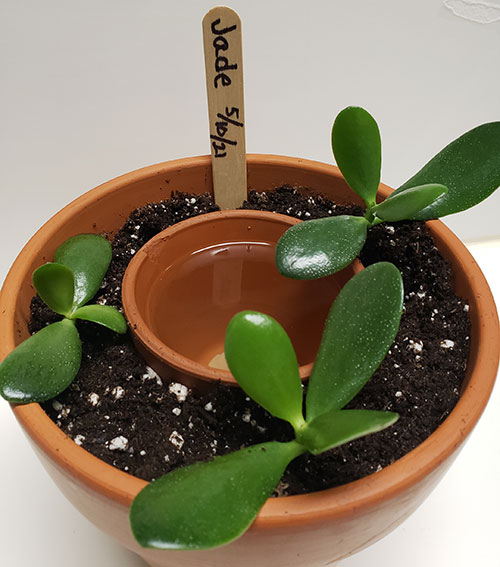
Cuttings may be rooted in regular flower pots, boxes, or flats. Good results are obtained by using two pots, one about 2 inches in diameter and the other about 6–8 inches in diameter. The rooting medium is put into the larger pot. Plug the drainage hole of the small pot, and set it in the center of the larger one level with the edge. The small pot is filled with water that seeps into the rooting medium where the cuttings have been inserted.
The cuttings should begin to form roots in 3 to 4 weeks and then they can be repotted into individual pots. The time varies by the type of plant. It is best to take cuttings when the plants are actively growing.
Another method is to place cuttings in a small amount of rooting medium in a large, covered glass jar or terrarium. Cuttings root quickly in such a moist protected enclosure, which can also be obtained by creating a plastic tent shelter. Use a bent wire coat hanger or wooden sticks to hold an ordinary plastic bag well above the tops of the cuttings.
While many plants will root easily in water, those roots aren’t high quality and will have trouble becoming established after they are transplanted into a container. The “soilless medium” provides good aeration, drainage, and moisture-holding characteristics while supporting the stem of the plant while roots develop.
Division
Division or separation is another easy and quick way to propagate plants that produce stems at their base. The new plants are obtained immediately, and they maintain the same characteristics as the parent or stock plant. It is for this reason that division is a favorite method of the amateur gardener.
Some houseplants propagated by division are snake plant, Boston fern, cast-iron plant, African violet, English ivy, philodendron, and vinca vine. Plants can be divided at any time, although doing so in the dormant or rest period is best.
To divide a plant, first remove it from the container. Then separate the stock plant into smaller pieces with a knife or your fingers. Each division should have some roots. Pot them in a sterilized mixture of one part sand, two parts peat moss, and two parts loam soil. Divisions without roots may be rooted as stem tip cuttings, as described above.
Additional Resources
- Bulletin #2611, Caring for Houseplants in Maine
- Bulletin #2612, Dealing with Houseplant Problems in Maine
- Bulletin #2613, Controlling Insects and Disease in Houseplants
- Bulletin #2614, Growing Houseplants Under Artificial Lights in Maine
- Bulletin #2516, FAQ About Houseplants in Maine
- Plant Propagation, UMaine Extension
- Bulletin, #2410, Plant Propagation in Maine
- Bulletin, #2751, Starting Seeds at Home
Sources
Houseplants in Maine by Lois Stack, Ornamental Horticulture Specialist, University of Maine Cooperative Extension
House Plant Tips by Gleason Gray, Extension Educator, Penobscot County, University of Maine Cooperative Extension
Information in this publication is provided purely for educational purposes. No responsibility is assumed for any problems associated with the use of products or services mentioned. No endorsement of products or companies is intended, nor is criticism of unnamed products or companies implied.
© 2021
Call 800.287.0274 (in Maine), or 207.581.3188, for information on publications and program offerings from University of Maine Cooperative Extension, or visit extension.umaine.edu.
In complying with the letter and spirit of applicable laws and pursuing its own goals of diversity, the University of Maine System does not discriminate on the grounds of race, color, religion, sex, sexual orientation, transgender status, gender, gender identity or expression, ethnicity, national origin, citizenship status, familial status, ancestry, age, disability physical or mental, genetic information, or veterans or military status in employment, education, and all other programs and activities. The University provides reasonable accommodations to qualified individuals with disabilities upon request. The following person has been designated to handle inquiries regarding non-discrimination policies: Director of Institutional Equity and Title IX Services, 5713 Chadbourne Hall, Room 412, University of Maine, Orono, ME 04469-5713, 207.581.1226, TTY 711 (Maine Relay System).

